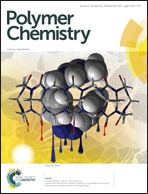Solution-processed small molecules based on benzodithiophene and difluorobenzothiadiazole for inverted organic solar cells†
Abstract
Monofluorinated small molecules have been proved to be promising donors for high performance small molecular solar cells (SMSCs). Herein, two solution-processable acceptor–donor–acceptor (A–D–A) type small molecules (SMs) with 4,8-bis(5-hexylthiophen-2-yl)benzo[1,2-b:4,5-b′]dithiophene (BDTT) as the donor core and benzothiadiazole (BT) or difluoro-2,1,3-benzothiadiazole (DFBT) as the acceptor unit, namely BDT(TBTTT6)2 and BDT(TffBTTT6)2 respectively, have been designed and synthesized to extensively investigate the effect of fluorination on the optoelectronic properties, molecular organization, and photovoltaic performance of SMSCs. The fluorinated BDT(TffBTTT6)2 shows a relatively broader and stronger absorbance, more favorable molecular packing and deeper highest occupied molecular orbital (HOMO) energy level than nonfluorinated BDT(TBTTT6)2, leading to a higher open-circuit voltage (Voc), circuit current (Jsc), fill factor (FF), and hole mobility in SMSCs. Additionally, the power conversion efficiency (PCE) is significantly improved from 1.76% to 4.17% for BDT(TffBTTT6)2 and from 1.3% to 3.17% for BDT(TBTTT6)2 based inverted devices after optimization by 1,8-diiodooctane (DIO) and thermal annealing (TA). It should be noted that the PCE of 4.17% is the highest reported value for the solution-processed inverted SMSCs based on BDT and BT units. Grazing incident X-ray diffraction (GIXRD), transmission electron microscopy (TEM) and atomic force microscopy (AFM) demonstrate that the fluorinated small molecule optimization by DIO and thermal annealing promote a more well-intermixed microphase morphology as well as a better donor/acceptor interpenetrating network in an active film for more efficient charge transfer and transportation than the nonfluorinated one, leading to a dramatic improvement in the device performance. These results unambiguously demonstrate that the introduction of F atoms into the molecular backbone as well as optimization by the solvent additive process can be an effective strategy for the development of electron-donating materials for stabilized inverted-based SMSCs.


 Please wait while we load your content...
Please wait while we load your content...